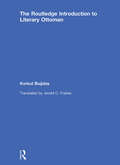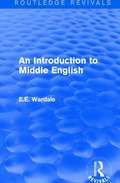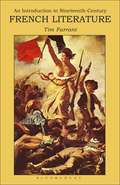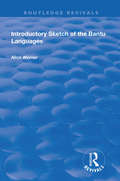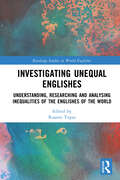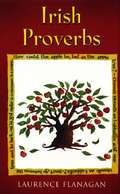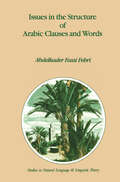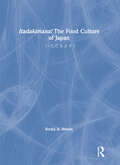- Table View
- List View
An Introduction to Japanese Linguistics (Blackwell Textbooks in Linguistics)
by Natsuko TsujimuraThe third edition of this established textbook has been thoroughly updated and revised. It maintains its broad coverage of topics from phonetics to language variation, and increases its accessibility by incorporating a more descriptive, less theoretical approach. A fully updated new edition of this successful textbook introducing students to a wide range of issues, phenomena, and terminology in Japanese linguistics Includes extensive revisions to the chapters on phonetics, syntax and phonology, and incorporates a less theoretical, more descriptive approach Features the author’s own data, examples and theoretical analyses throughout Offers an original approach by discussing first and/or second language acquisition within each chapter Includes exercises exploring descriptive and theoretical issues and reading lists which introduce students to the research literature, both of which have been updated in this new edition
An Introduction to Japanese Linguistics (Blackwell Textbooks in Linguistics)
by Natsuko TsujimuraThe third edition of this established textbook has been thoroughly updated and revised. It maintains its broad coverage of topics from phonetics to language variation, and increases its accessibility by incorporating a more descriptive, less theoretical approach. A fully updated new edition of this successful textbook introducing students to a wide range of issues, phenomena, and terminology in Japanese linguistics Includes extensive revisions to the chapters on phonetics, syntax and phonology, and incorporates a less theoretical, more descriptive approach Features the author’s own data, examples and theoretical analyses throughout Offers an original approach by discussing first and/or second language acquisition within each chapter Includes exercises exploring descriptive and theoretical issues and reading lists which introduce students to the research literature, both of which have been updated in this new edition
Introduction to Korean as a Second Language
by EunHee LeeIntroduction to Korean as a Second Language introduces the basic linguistic make-up of Korean and provides basic knowledge of second language acquisition and up-to-date research on how Korean is learned by adult second language learners (L2 Korean learners).The book synthesizes the existing research and suggests future directions for this relatively new but rapidly growing field. The book covers topics such as the Korean sound system, word and phrase structures of Korean, and meaning in Korean, making it a great resource for those who want to deepen their understanding of the Korean language. This textbook is ideal for use in Korean linguistics courses, and teaching and learning Korean as a foreign language courses. The book would also be good supplementary material for Korean language classes.
Introduction to Korean as a Second Language
by EunHee LeeIntroduction to Korean as a Second Language introduces the basic linguistic make-up of Korean and provides basic knowledge of second language acquisition and up-to-date research on how Korean is learned by adult second language learners (L2 Korean learners).The book synthesizes the existing research and suggests future directions for this relatively new but rapidly growing field. The book covers topics such as the Korean sound system, word and phrase structures of Korean, and meaning in Korean, making it a great resource for those who want to deepen their understanding of the Korean language. This textbook is ideal for use in Korean linguistics courses, and teaching and learning Korean as a foreign language courses. The book would also be good supplementary material for Korean language classes.
An Introduction to Korean Linguistics
by Eunhee Lee Sean Madigan Mee-Jeong ParkAn Introduction to Korean Linguistics is a valuable and comprehensive text for those with an interest in Korean linguistics. This book provides an in-depth introduction to the basics of Korean linguistics, and modern linguistic theory, in an accessible style. It features a step-by-step approach designed to lead the reader through the linguistic make-up of the language, from the basics of its sound system and sentence structure to the semantics of modern spoken Korean. Features include: Detailed chapters covering the core areas in the field of linguistics, including phonetics, phonology, morphology and syntax Clear and accessible explanations which effectively demonstrate the intricacies and subtleties of the Korean language Suggested readings for those interested in expanding their knowledge of a specific topic Exercises designed to complement the factual and analytical issues covered in each chapter A comprehensive glossary of central terms and a companion website offering a wealth of additional materials. Korean is an invaluable language for the study of theoretical and comparative linguistics as it provides important examples and counter-examples to key issues, making An Introduction to Korean Linguistics an essential text for students and professional linguists alike.
An Introduction to Korean Linguistics
by Eunhee Lee Sean Madigan Mee-Jeong ParkAn Introduction to Korean Linguistics is a valuable and comprehensive text for those with an interest in Korean linguistics. This book provides an in-depth introduction to the basics of Korean linguistics, and modern linguistic theory, in an accessible style. It features a step-by-step approach designed to lead the reader through the linguistic make-up of the language, from the basics of its sound system and sentence structure to the semantics of modern spoken Korean. Features include: Detailed chapters covering the core areas in the field of linguistics, including phonetics, phonology, morphology and syntax Clear and accessible explanations which effectively demonstrate the intricacies and subtleties of the Korean language Suggested readings for those interested in expanding their knowledge of a specific topic Exercises designed to complement the factual and analytical issues covered in each chapter A comprehensive glossary of central terms and a companion website offering a wealth of additional materials. Korean is an invaluable language for the study of theoretical and comparative linguistics as it provides important examples and counter-examples to key issues, making An Introduction to Korean Linguistics an essential text for students and professional linguists alike.
An Introduction to Literary Ottoman
by Korkut BugdayThis represents the first modern introduction to literary Ottoman available in English. The author has devised this textbook to provide a course of lessons, readings and exercises to take the student from beginner to intermediate level. The book features numerous readings taken from historiography, historical, literary, journalistic and legal sources from the 16th to the 20th century. This will be an essential tool for Ottomanists and other scholars in a broad range of academic disciplines that include Ottoman history and literature, language, art, music and architecture of the former empire.
An Introduction To Middle English
by Simon Horobin Jeremy SmithAn Introduction to Middle Englishis designed to provide undergraduate students of English historical linguistics with a concise description of the language during the period 1100-1500. Middle English, the language of Chaucer, is discussed in relation to both earlier and later stages in the history of English, and in relation to other languages with which it came into contact. Features:* the historical and geographical contexts of Middle English* the evidence for Middle English* the principal features of Middle English spelling, pronunciation, grammar and vocabulary* an introduction to Middle English textual studies* selected Middle English texts, both literary and non-literary* notes, glossaries and annotated bibliographies* questions for reviewMost other introductory books on Middle English focus on literary rather than linguistic matters; this book is designed to redress the balance, by providing students of English language with an up-to-date, authoritative survey which takes account of recent trends in historical linguistics.
An Introduction To Middle English (PDF)
by E. E. WardaleFirst published in 1937, this book supplies a history of the living growth of the English language from Old English to the medieval period. It offers an in-depth study of the growth of vocabulary through literature and social interaction, bringing out the fact that it is chiefly words that foreign influence has affected #65533; leaving sentence structure almost unaltered. Isolative and combinative changes in phonology, the accidence of nouns and plurals, pronouns and adverbs, and verbs are also examined in detail, along with a general overview of the features Middle English and a brief outline of each dialect#65533;s most striking characteristics.
Introduction to Modern Arabic (Princeton Legacy Library #5500)
by Richard Bayly Winder Farhat Jacob ZiyadehThis book introduces the student to modern literary Arabic, particularly the style used in newspapers, without undue emphasis on the finder points of grammar found in advanced reference works. Various phrases of Middle Eastern life are presented in simple narrative texts which exemplify points analyzed in each chapter. The appendices indclude paradigms, a list of verbs and their prepositions, and vocabularies. Here are all the necessary tools for a well-organized attack on a comparatively difficult language.Published for the Department of Oriental Languages, Princeton University.Originally published in 1957.The Princeton Legacy Library uses the latest print-on-demand technology to again make available previously out-of-print books from the distinguished backlist of Princeton University Press. These editions preserve the original texts of these important books while presenting them in durable paperback and hardcover editions. The goal of the Princeton Legacy Library is to vastly increase access to the rich scholarly heritage found in the thousands of books published by Princeton University Press since its founding in 1905.
Introduction to Nineteenth-Century French Literature
by Tim FarrantEveryone knows something of nineteenth-century France - or do they? "Les Miserables", "The Lady of the Camelias" and "The Three Musketeers", "Balzac" and "Jules Verne" live in the popular consciousness as enduring human documents and cultural icons. Yet, the French nineteenth century was even more dynamic than the stereotype suggests. This exciting new introduction takes the literature of the period both as a window on past and present mindsets and as an object of fascination in its own right. Beginning with history, the century's biggest problem and potential, it looks at narrative responses to historical, political and social experience, before devoting central chapters to poetry, drama and novels - all genres the century radically reinvented. It then explores numerous modernities, ways nineteenth-century writing and mentalities look forward to our own, before turning to marginalities - subjects and voices the canon traditionally forgot. No genre was left unchanged by the nineteenth century. This book will help to discover them anew.
Introduction to Nineteenth-Century French Literature
by Tim FarrantEveryone knows something of nineteenth-century France - or do they? "Les Miserables", "The Lady of the Camelias" and "The Three Musketeers", "Balzac" and "Jules Verne" live in the popular consciousness as enduring human documents and cultural icons. Yet, the French nineteenth century was even more dynamic than the stereotype suggests. This exciting new introduction takes the literature of the period both as a window on past and present mindsets and as an object of fascination in its own right. Beginning with history, the century's biggest problem and potential, it looks at narrative responses to historical, political and social experience, before devoting central chapters to poetry, drama and novels - all genres the century radically reinvented. It then explores numerous modernities, ways nineteenth-century writing and mentalities look forward to our own, before turning to marginalities - subjects and voices the canon traditionally forgot. No genre was left unchanged by the nineteenth century. This book will help to discover them anew.
Introduction to TESOL: Becoming a Language Teaching Professional
by Kate Reynolds Kenan Dikilitaş Steve CloseA comprehensive introduction to TESOL for new and future teachers of English, offering a full and detailed view of the process of becoming a language teacher Introduction to TESOL: Becoming a Language Teaching Professional presents an expansive and well-balanced view of both the interdisciplinary knowledgebase and professional opportunities in the field of language teaching. Written to help aspiring TESOL educators understand how to begin their careers, this comprehensive textbook covers both the foundational linguistic elements of TESOL as well as the practical pedagogical aspects of the discipline. Written with the needs of the introductory student in mind, this book delves into the essentials of English as a Second Language (ESL) and English as a Foreign Language (EFL) teaching, covering professional organizations, language acquisition theories, instructional practices, professional development, and more. Readers are provided with clear descriptions of recent research and contemporary practices, numerous illustrations and examples highlighting key material, and engaging real-world vignettes from professionals teaching internationally. Offering a coherent overview and contextualized orientation of the field of TESOL, this guide: Discusses the differences in TESOL approaches in international settings Addresses the current state and potential future of TESOL with a view for new developments in teaching pedagogy and language research Explores the history and development of the field, including the political, social, and cultural decisions made about language teaching and learning Describes the specializations, niches, and subfields within the discipline of TESOL Explains what, how and why TESOL educators need a working understanding of linguistics and second language acquisition theories Outlines the scope of the profession and how to engage in professional organizations to grow in expertise Introduction to TESOL: Becoming a Language Teaching Professional is essential reading for students and educators planning to enter this dynamic and rewarding area of language teaching.
Introduction to TESOL: Becoming a Language Teaching Professional
by Kate Reynolds Kenan Dikilitaş Steve CloseA comprehensive introduction to TESOL for new and future teachers of English, offering a full and detailed view of the process of becoming a language teacher Introduction to TESOL: Becoming a Language Teaching Professional presents an expansive and well-balanced view of both the interdisciplinary knowledgebase and professional opportunities in the field of language teaching. Written to help aspiring TESOL educators understand how to begin their careers, this comprehensive textbook covers both the foundational linguistic elements of TESOL as well as the practical pedagogical aspects of the discipline. Written with the needs of the introductory student in mind, this book delves into the essentials of English as a Second Language (ESL) and English as a Foreign Language (EFL) teaching, covering professional organizations, language acquisition theories, instructional practices, professional development, and more. Readers are provided with clear descriptions of recent research and contemporary practices, numerous illustrations and examples highlighting key material, and engaging real-world vignettes from professionals teaching internationally. Offering a coherent overview and contextualized orientation of the field of TESOL, this guide: Discusses the differences in TESOL approaches in international settings Addresses the current state and potential future of TESOL with a view for new developments in teaching pedagogy and language research Explores the history and development of the field, including the political, social, and cultural decisions made about language teaching and learning Describes the specializations, niches, and subfields within the discipline of TESOL Explains what, how and why TESOL educators need a working understanding of linguistics and second language acquisition theories Outlines the scope of the profession and how to engage in professional organizations to grow in expertise Introduction to TESOL: Becoming a Language Teaching Professional is essential reading for students and educators planning to enter this dynamic and rewarding area of language teaching.
An Introduction to the Languages of the World
by Brett Kessler Anatole Lyovin William LebenUnique in scope, An Introduction to the Languages of the World introduces linguistics students to the variety of world's languages. Students will gain familiarity with concepts such as sound change, lexical borrowing, diglossia, and language diffusion, and the rich variety of linguistic structure in word order, morphological types, grammatical relations, gender, inflection, and derivation. It offers the opportunity to explore structures of varying and fascinating languages even with no prior acquaintance. A chapter is devoted to each of the world's continents, with in-depth analyses of representative languages of Europe, Asia, Africa, Oceania, and America, and separate chapters cover writing systems and pidgins and creoles. Each chapter contains exercises and recommendations for further reading. New to this edition are eleven original maps as well as sections on sign languages and language death and revitalization. For greater readability, basic language facts are now organized in tables, and language samples follow international standards for phonetic transcription and word-by-word glossing. There is an instructor's manual available for registered instructors on the book's companion website.
An Introduction to the Languages of the World
by Anatole Lyovin Brett Kessler William LebenUnique in scope, An Introduction to the Languages of the World introduces linguistics students to the variety of world's languages. Students will gain familiarity with concepts such as sound change, lexical borrowing, diglossia, and language diffusion, and the rich variety of linguistic structure in word order, morphological types, grammatical relations, gender, inflection, and derivation. It offers the opportunity to explore structures of varying and fascinating languages even with no prior acquaintance. A chapter is devoted to each of the world's continents, with in-depth analyses of representative languages of Europe, Asia, Africa, Oceania, and America, and separate chapters cover writing systems and pidgins and creoles. Each chapter contains exercises and recommendations for further reading. New to this edition are eleven original maps as well as sections on sign languages and language death and revitalization. For greater readability, basic language facts are now organized in tables, and language samples follow international standards for phonetic transcription and word-by-word glossing. There is an instructor's manual available for registered instructors on the book's companion website.
Introductory Sketch of the Bantu Languages (Routledge Revivals)
by Alice WernerFirst published in 1919, this volume provides a detailed linguistic breakdown of the Bantu language family of Central and Southern Africa. Its author held in-situ expertise in Nanja, Swahili, Zulu, Giryama and Pokomo. A professor of Swahili and Bantu languages, she was the author of several books on Bantu languages and African peoples. The volume aims to depict the broad principles underlying the structure of the Bantu language family and attempts a classification of those languages. Contemporaneous with the colonization of Tanzania, many of the areas to which this volume was relevant were under British control at the time of publication.
Introductory Sketch of the Bantu Languages (Routledge Revivals)
by Alice WernerFirst published in 1919, this volume provides a detailed linguistic breakdown of the Bantu language family of Central and Southern Africa. Its author held in-situ expertise in Nanja, Swahili, Zulu, Giryama and Pokomo. A professor of Swahili and Bantu languages, she was the author of several books on Bantu languages and African peoples. The volume aims to depict the broad principles underlying the structure of the Bantu language family and attempts a classification of those languages. Contemporaneous with the colonization of Tanzania, many of the areas to which this volume was relevant were under British control at the time of publication.
Investigating Unequal Englishes: Understanding, Researching and Analysing Inequalities of the Englishes of the World (Routledge Studies in World Englishes)
by Ruanni TupasRuanni Tupas presents rich insights into the inequalities of Englishes and the ways in which these inequalities shape and impact English and multilingual speakers from around the world.This edited volume gives a critical take on world Englishes, while showcasing for readers the various inequalities in treatment towards the people who speak English differently, as well as the injustice in that treatment. Research methodologies are explored, providing a glimpse into how data are collected and lending a more thorough look into each study and its conclusions. Chapters address the geopolitics of knowledge production in the teaching, learning and use of English, with strong representations from the peripheries of sociolinguistic studies of English. English is constructed as a language which enables socioeconomic mobility which is one factor that increases the importance of research into this issue, and this book enables researchers to widen their methods of research and apply them to their area of study.A valuable text for academic researchers, as well as postgraduate and advanced undergraduate students, to better understand the linguistic, sociopolitical and epistemic inequality in English communication. It also provides readers with alternative perspectives on lingua-cultural pluralism to unpack social inequalities and hierarchies that exist today.
Investigating Unequal Englishes: Understanding, Researching and Analysing Inequalities of the Englishes of the World (Routledge Studies in World Englishes)
by Ruanni TupasRuanni Tupas presents rich insights into the inequalities of Englishes and the ways in which these inequalities shape and impact English and multilingual speakers from around the world.This edited volume gives a critical take on world Englishes, while showcasing for readers the various inequalities in treatment towards the people who speak English differently, as well as the injustice in that treatment. Research methodologies are explored, providing a glimpse into how data are collected and lending a more thorough look into each study and its conclusions. Chapters address the geopolitics of knowledge production in the teaching, learning and use of English, with strong representations from the peripheries of sociolinguistic studies of English. English is constructed as a language which enables socioeconomic mobility which is one factor that increases the importance of research into this issue, and this book enables researchers to widen their methods of research and apply them to their area of study.A valuable text for academic researchers, as well as postgraduate and advanced undergraduate students, to better understand the linguistic, sociopolitical and epistemic inequality in English communication. It also provides readers with alternative perspectives on lingua-cultural pluralism to unpack social inequalities and hierarchies that exist today.
Irish Proverbs: A Collection of Irish Proverbs, Old and New
by Laurence FlanaganThere are millions of Irish proverbs, old and new, and Laurence Flanagan has made a wide-ranging collection of these proverbs, some well known, some obscure, and has provided both Irish and English text for them.
Ismail Kadare: The Writer and the Dictatorship 1957-1990
by Peter MorganIsmail Kadare has experienced a life of controversy. In his own country and internationally he has been both acclaimed as a writer and condemned as a lackey of the Albanian socialist dictatorship. Coming of age after occupation and war, Kadare (b. 1936) belonged to the first generation of new Albanians. In a land where writers were routinely imprisoned, Kadare produced the most brilliant and subversive works to emerge from socialist Eastern Europe. His work brings to an end the century whose literary beginnings were marked by the terror to which Kafka gave his name. The inaugural award of the International Man-Booker Prize for Literature in 2005 marked an important milestone in the global recognition of Kadare. Ironic, multi-layered and imaginative, Kadare's writing is profoundly opposed to ideology. Through critical analysis of a representative selection of Kadare's works, Peter Morgan explains for a wide audience how Kadare survived and wrote in the repressive Albanian Stalinist environment. Peter Morgan is Professor of European Studies at the University of Western Australia.
Ismail Kadare: The Writer and the Dictatorship 1957-1990
by Peter MorganIsmail Kadare has experienced a life of controversy. In his own country and internationally he has been both acclaimed as a writer and condemned as a lackey of the Albanian socialist dictatorship. Coming of age after occupation and war, Kadare (b. 1936) belonged to the first generation of new Albanians. In a land where writers were routinely imprisoned, Kadare produced the most brilliant and subversive works to emerge from socialist Eastern Europe. His work brings to an end the century whose literary beginnings were marked by the terror to which Kafka gave his name. The inaugural award of the International Man-Booker Prize for Literature in 2005 marked an important milestone in the global recognition of Kadare. Ironic, multi-layered and imaginative, Kadare's writing is profoundly opposed to ideology. Through critical analysis of a representative selection of Kadare's works, Peter Morgan explains for a wide audience how Kadare survived and wrote in the repressive Albanian Stalinist environment. Peter Morgan is Professor of European Studies at the University of Western Australia.
Issues in the Structure of Arabic Clauses and Words (Studies in Natural Language and Linguistic Theory #29)
by A. Fassi FehriThis study has a twofold goal. First, it investigates the internal structure of words and clauses in Standard Arabic (SA), in the light of recent developments of Government and Binding Theory (GB). Second, it argues for a specific theory of typology, and proposes a particular view of how parametrization can be construed and executed. SA is a language used throughout the Arab world, in contrast to specific local dialects which are limited to a particular area. The language has a number of features which make it particularly suitable for cross-linguistic comparative morpho-syntax, as well as research in different modules of the theory of grammar. SA morphology is essentially non-concatenative, though a rich analytic affixation system makes word formation hierarchical. Word order in SA is basically VSO, but the language has alternative SVO structures as well. Sentences can be 'nominal' (i.e. with no verb or copula realized at surface structure), or verbal. Arguments can be left syntacti cally unexpressed (i.e. SA is a null argument language). SA is an agreement language, with a rich and complex agreement system interacting with word order, pronominal incorporation, and expletive structures. It also has a productive morphological case system. Tense, Aspect, Modal, and Negation properties interact in intriguing ways. Finally, SA's DP system exhibits interesting complementary distributions between overt determiners, genitive complements, and possessive markers. It also uses different licensing strategies for Genitive Case marking.
Itadakimasu! The Food Culture of Japan: いただきます!
by Becky A. BrownItadakimasu! The Food Culture of Japan is designed as a first- or second-year college course in Japanese culture for students who have little to no background in the Japanese language, culture, literature, or history. Unlike any other culture text, Itadakimasu! offers a unique approach to learning about culture through a country’s cuisine. This account takes students on an exciting journey into the world of Japanese food culture, both past and present, exploring themes such as regional specialties, annual festivals, traditional foodways, prominent tea masters, culinary expressions, restaurant menus, dining etiquette, mealtime customs, and culinary aesthetics. Itadakimasu! also addresses current events in the food industry and agribusiness, health and nutrition, dieting trends, fast food, and international and Western influences. Enhancing this wealth of cultural material are autobiographical essays written by guest contributors and varied literary excerpts featuring food themes across different genres in literature spanning many centuries. Each of the readings is supplemented by general comprehension questions followed by more probing queries calling on critical and analytical thinking to methodically guide students from a cursory understanding of a new culture to reflections on their own experiences and other world cultures. Resources also highlight food-centric films so that students can witness what they are learning about in an authentic cultural context. Furthermore, teachers and students alike can enjoy food tasting labs in the classroom, fostering yet another authentic experience for the students. With the intention of reaching a broad audience of students majoring or minoring in Japanese or Asian Studies, or students learning English as a Foreign Language or English for Specific Purposes, Itadakimasu! could also be useful for composition and conversation courses and the Writing Across the Curriculum series or as a supplement for 'Four Skills' Japanese language courses and introductory Japanese literature offerings. Above all, its multifaceted design with a broad spectrum of self-contained sections welcomes individual teaching styles and preferences. Itadakimasu! paints an appetizing image of Japan’s society with just a dash of culture, a pinch of language, and a taste of literature to tempt the palate of students new to the study of Japan. Meant to enhance the regular curriculum, this innovative approach to learning about Japan suggests that the culinary world can lend an insightful view into a country’s culture. Historical and contemporary foodways are universal elements common to all cultures, making the subject matter inherently relatable. An Instructors Manual containing sample syllabi, learning outcomes, handout templates, study guides, background content and more is available at www.routledge.com/9780367903572.



